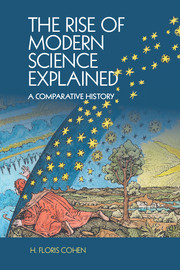Book contents
- Frontmatter
- Contents
- Introduction: the Old World and the New
- 1 To begin at the beginning: nature-knowledge in Greece and China
- 2 Islamic civilisation and medieval and Renaissance Europe
- 3 Three revolutionary transformations
- 4 A crisis surmounted
- 5 Expansion, threefold
- 6 Revolutionary transformation continued
- Epilogue: a look back and a look ahead
- Timeline 1: pre-1600
- Timeline 2: 1600–1700
- A note on the literature
- Provenance of quoted passages
- Index
3 - Three revolutionary transformations
Published online by Cambridge University Press: 05 March 2016
- Frontmatter
- Contents
- Introduction: the Old World and the New
- 1 To begin at the beginning: nature-knowledge in Greece and China
- 2 Islamic civilisation and medieval and Renaissance Europe
- 3 Three revolutionary transformations
- 4 A crisis surmounted
- 5 Expansion, threefold
- 6 Revolutionary transformation continued
- Epilogue: a look back and a look ahead
- Timeline 1: pre-1600
- Timeline 2: 1600–1700
- A note on the literature
- Provenance of quoted passages
- Index
Summary
Around 1600 the Scientific Revolution broke out. Or, to put it more precisely, a revolution occurred within each of the three modes of nature-knowledge that had flowered during the previous one and a half centuries. But the great paradox of the Scientific Revolution is that the one that underwent the most radical change was the most oriented towards the past. Against all those well-grounded expectations of our trend-watcher, ‘Alexandria’ turned out not to be nearing the end of its potential for development but really formed the inner core of a fundamental transformation into a largely new mode of nature-knowledge that I shall here call ‘Alexandria-plus’. And those responsible for this revolutionary transformation were the same Johannes Kepler and Galileo Galilei who a few years earlier had largely failed in their attempts, undertaken with greater boldness than ever before, to enrich ‘Alexandria’. It is through their doing that the time bomb which for half a century had quietly been ticking away in Copernicus’ book now suddenly exploded.
KEPLER AND GALILEO: FROM ‘ALEXANDRIA’ TO ‘ALEXANDRIA-PLUS’
Kepler and Galileo never met. One lived in the German-Austrian part of the Habsburg Empire (Graz, Prague, Linz) while the other lived in Italy (Pisa, Padua, Florence). They did exchange a few letters, and Kepler was keen to continue the correspondence, but Galileo held him at arm's length except for the one occasion when he urgently needed Kepler's help. Not only were their characters very different but also their methods and the core problems to which they dedicated their respective careers. What they had in common was intellectual brilliance and a deeply felt need to make mathematics deal with the real world. Kepler derived that desire from Ptolemy, who in his own way had taken some steps in the same direction. For Kepler its urgency was rooted in his conviction that, as Copernicus had argued in Book I half a century earlier, the Earth really is a planet and really does rotate on its axis each day and revolve around the Sun every year. Only, with Copernicus this idea, even if supported in Book I by several arguments, was hard to reconcile with the detailed models that he produced in Books II–VI in the time-honoured ‘save the phenomena’ style of the Almagest.
- Type
- Chapter
- Information
- The Rise of Modern Science ExplainedA Comparative History, pp. 102 - 144Publisher: Cambridge University PressPrint publication year: 2015



